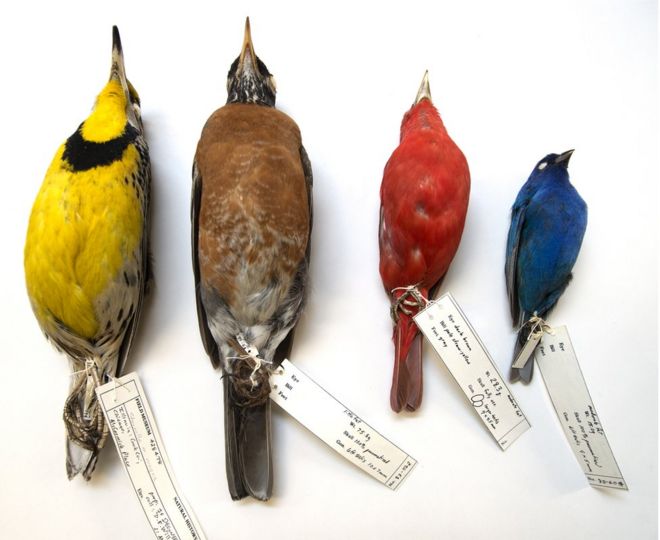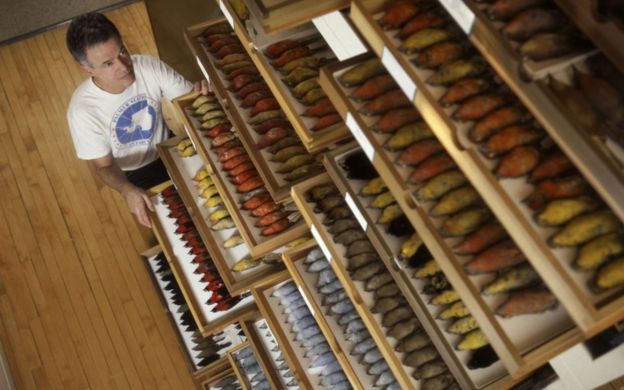Silent World
"We had good reason to expect that increasing temperatures would lead to reductions in body size, based on previous studies."
"The thing that was shocking was how consistent it was. I was incredibly surprised that all of these species are responding in such similar ways."
"Periods of rapid warming are followed really closely by periods of decline in body size, and vice versa."
"Being able to show that kind of detail in a morphological study is unique to our paper, as far as I know, and it's entirely due to the quality of the dataset that David Willard generated."
"It's clear that there's a third component -- changes in body size and shape -- that's probably going to interact with changes in range and changes in timing to determine how effectively a species can respond to climate change."
Brian Weeks, assistant professor, University of Michigan School for Environment and Sustainability
 |
| The researchers analysed 52 different species of migratory birds The Field Museum |
"When we began collecting the data analyzed in this study, we were addressing a few simple questions about year-to-year and season-to-season variations in birds."
"The phrase 'climate change' as a modern phenomenon was barely on the horizon. The results from this study highlight how essential long-term data sets are for identifying and analyzing trends caused by changes in our environment."
"The changes that are being documented are not something you could see with your eye."
"Birds with longer and more pointed wings might be more efficient fliers [compensating for heat-caused stress]."
David Willard, ornithologist, Field Museum of Natural History
 |
| Dave Willard with the Field Museum's vast collection of bird specimens, 1999 |
"Warming temperatures seem to be having a pretty consistent and almost universal effect on a large number of different species, regardless of other aspects of their biology."Published in the journal Ecology Letters, a new study out of the University of Michigan has shone a light on one aspect of how a warming climate is affecting bird populations; as the planet goes through a warming period, birds are adapting to the stress they are experiencing by becoming gradually smaller in size. That many bird populations appear as well to be declining is part of the same story. This aspect of adaptation rather than decline owes much to a collection gathered by Dr. Willard who has measured Chicago's dead birds since the year 1978.
"In years when temperatures were a bit warmer, the bodies got smaller. In years when temperatures were a bit cooler, we saw an increase in body size, even though the long-term trend was to decline."
"So that leads us to believe that temperature is pretty important here."
Benjamin Winger, evolution and ecology of birds, University of Michigan
The vast collection and the data accompanying it gave measure to the study of long-term trends in bird bodies; the measurements of their legs, and their lesser weight, and slightly longer wings. These were changes that Dr.Willard detailed measuring with calipers and scales and achieving a notable collection of birds upon whose measurements conclusions could be reached, along with tracked weather trends.
 |
| Ledger, measuring tools, and a Tennessee Warbler. |
The study of 70,716 bird specimens representing a 40-year accumulation of birds that had been found dead in Chicago as a result of misadventures such as flying into high-rise windows yielded the conclusion that the measured changes are present in close to all the species measured; the result of a seemingly inexorable, changing climate. When Dr. Willard began gathering birds for the museum's collection, climate change would have been the last thing on his mind.
He went about studiously measuring beaks, legs, body mass and wings, representing standard ornithological dimensions simply to satisfy his curiosity relating to seasonal trends. His activities attracted other museum staff and the Chicago Bird Collision Monitors, a volunteer organization which collects birds injured by windows. Those birds that were injured and could be rehabilitated were cared for by volunteers, while the dead ones were donated to the museum collection.
Dr. Willard had completed the records of measurements of over 70,000 birds of 52 species by 2016; his ledgers a minefield of explosive data all pointing to birds morphing over time in lock-step with climate change. Swamp sparrows and dark-eyed juncos were among the fifteen species of common birds that represented the majority of the collected specimens, although the collection also has several birds rare for the area. Birds on average surrendered 2.6 percent of their body mass; their legs became shorter by 2.4 percent, and their wings lengthened by 1.3 percent, from 1978 to 2016.
 |
Although there has been a 29 percent decline in North American bird populations since 1970, Dr. Winger hesitates to say whether these small size reductions are harmful to birds. Among data studied by the authors were precipitation, vegetation and allied factors that might contribute to size reduction, determining that an increase in summer temperatures was the strongest predictor for smaller birds emerging.
There is larger surface-area-to-volume ratios with smaller animals, allowing them to lose body heat more quickly. Leading to the proposal that hotter temperatures could stress birds, encouraging them to adapt by becoming smaller, to stay cooler. Research by Simon Griffith, an ecologist at Macquarie University in Australia where zebra finches and house sparrows were studied both in the lab and in the wild, indicates that hot temperatures during breeding season reduces bird offspring size and when fledglings are faced with heat stress they tend not to grow large.
Labels: Birds, Climate, Environment, Nature, Research, Science


0 Comments:
Post a Comment
<< Home